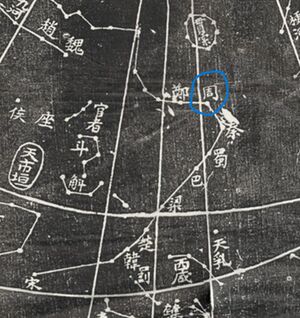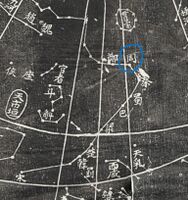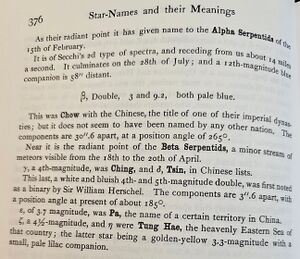Zhou (周)
Zhou
This is a traditional Chinese star name of one of the stars in the historical Chinese constellation of Tianshi (Celestial Marketplace).
Etymology and History of the Name
Since the Han dynasty, the number of stars in the Tianshi (Celestial Market) were fixed at 22, with each star representing a different state or region. The names of these states mostly originated from the Spring and Autumn(770 BCE - 476 BCE) and Warring States (475 BCE - 221 BCE) periods.
The name "Zhou [周]" comes from the Zhou dynasty (1046 BCE - 256 BCE), which established a powerful state after overthrowing the Shang dynasty and enfeoffed many vassals. However, after the fall of the Western Zhou (1046 BCE - 771 BCE), the Eastern Zhou (770 BCE - 256 BCE) moved the capital to Luoyang, and their power gradually weakened. The vassals grew stronger and no longer recognized the Zhou's authority, declaring themselves kings and reducing Zhou's territory to a small area. Thus, in the Tianshiyuan, Zhou did not hold a transcendent position but was on par with other regional vassal states.
The Tianshi-constellation consisting of 22 stars was formed at the Western Han (202 BCE - 8 CE) period, with star names changing before the Tang dynasty. Ever since the establishment of the Tianshi constellation, the star name "Zhou" (identified as β Ser) has always been one of the stars in the Celestial Marketplace. For approximately 2000 years, this star name is unchanged.
| Star Name | Ho PENG YOKE[1] | Yi Shitong[2]
Based on catalogue in 18th century |
Pan Nai[3]
based on Xinyixiangfayao Star Map |
Pan Nai[4]
based on catalogues in Yuan dynasty |
SUN X. & J. Kistemaker[5]
Han Dynasty |
Boshun Yang[6]
before Tang dynasty |
Boshun Yang[6]
Song Jingyou(1034) |
|---|---|---|---|---|---|---|---|
| Zhou | β Ser | β Ser | β Ser | β Ser | β Ser | β Ser | β Ser |
Images
- Zhou
IAU Star Name
The word is simple, short and easy - even for people who don't know Chinese.
The star name "Chow" is already in SIMBAD and correctly associated with beta Serpentis (SIMBAD), so the WGSN should register this name in the IAU-Catalog of Star Names. However, the correct spelling in Pinyin Chinese would be "Zhou".
Usage of the name in modern texts
At least these six papers already used the name (although in old spelling) which shows its acceptance.
- John Reeves, Esq. F.R.&L.S. ""Chinese Names of Stars and Constellations collected at the Request of the Author of this Dictionary"" in Robert Morrison (1819) ""A Dictionary of the Chinese Language in Three Parts, Volumes 1-2"" (Honorable East India Company's Press).
- Richard Hinckley Allen (1899) ""Star-Names and their Meanings"" (G.E. Stechert, New York).
- Robert Burnham, Jr. (1978) ""Burnham's Celestial Handbook: An Observer's Guide to the Universe Beyond the Solar System"" (Dover Publications).
- Howard Schneider (2009) ""Backyard Guide to the Night Sky"" (National Geographic Books).
- Shaya E.J. & Olling R.P. (2011; 2011ApJS..192....2S) ""Very wide binaries and other comoving stellar companions: a Bayesian analysis of the Hipparcos catalogue"".
- Jones et al. (2015; 2015ApJ...813...58J) ""The ages of A-stars. I. Interferometric observations and age estimates for stars in the Ursa Major moving group"".
Obviously, the name and the spelling appears to have started appearing in international literature after appearing in the work by John Reeves, Esq. F.R.&L.S. "Chinese Names of Stars and Constellations collected at the Request of the Author of this Dictionary" in Robert Morrison (1819) "A Dictionary of the Chinese Language in Three Parts, Volumes 1-2" (Honorable East India Company's Press), and it was later spread through Richard Hinckley Allen's (1899) "Star-names and their meanings" (G.E. Stechert, New York). Although Allen (1899) is known to be partially outdated and incorrect, this book has been one of the best sold and most commonly known references for star names in the 20th century.
This is a case where the Chinese name was uniquely attributed to this star, i.e. not an entire asterism - strengthening its attachment.
Other names for this star
The only other name for bet Ser that we are aware of is "Nasak Shamiya I" from Rhoads (1971), from the Arabic asterism that Rhoads transliterated as "Nasaḳ Shāmiyy". Danielle Adams in her PhD thesis (p.166) transliterated this as "al-nasaq al-shāmī " which makes the name even longer and more complicated. Regardless, this was an asterism with several stars, and the Rhoads version of the name with the Roman numeral did not really come into common usage.
References
- ↑ P.-Y. Ho, “Ancient And Mediaeval Observations of Comets and Novae in Chinese Sources,” Vistas in Astronomy, 5 (1962), 127-225.
- ↑ Yi Shitong [伊世同]. Zhongxi Duizhao Hengxing Tubiao [中西对照恒星图表1950]. Beijing: Science Press. 1981: p. 56.
- ↑ Pan Nai [潘鼐]. Zhongguo Hengxing Guance shi [中国恒星观测史]. Shanghai: Xuelin Pree. 1989. p. 226.
- ↑ Pan Nai [潘鼐]. Zhongguo Hengxing Guance shi [中国恒星观测史]. Shanghai: Xuelin Pree. 2009. p. 443.
- ↑ Sun Xiaochun & Kistemaker J. The Chinese sky during the Han. Leiden: Brill. 1997, pp. 241-6.
- ↑ 6.0 6.1 B.-S. Yang [杨伯顺], Zhongguo Chuantong Hengxing Guance Jingdu ji Xingguan Yanbian Yanjiu [中国传统恒星观测精度及星官演变研究] (A Research on the Accuracy of Chinese Traditional Star Observation and the Evolution of Constellations), PhD thesis, (Hefei: University of Science and Technology of China, 2023). p. 261.








